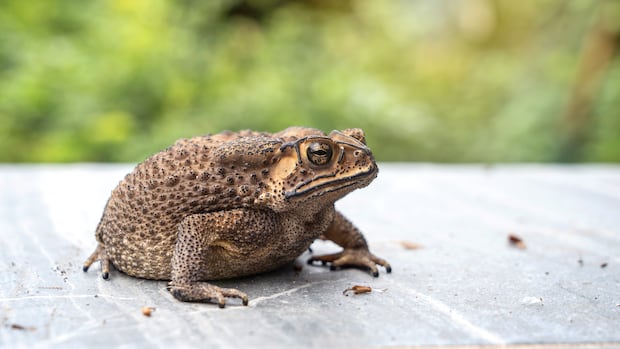As It Happens6:17Toads conquered the world with their poisonous sacs — and humans helped them
There’s a toad invasion underfoot. No, really. According to a new study that analyzed the DNA of 124 species of toads, you can now find them on six of seven continents with a colony most-recently spreading fast in East Africa.
And some scientists believe a big part of the toad takeover has to do with how the warty, tough-skinned creatures are built.
“They are packed with poisons,” Chris Raxworthy, co-author of the study and curator of herpetology at the American Museum of Natural History told As It Happens host Nil Koksal.
“Many toads have these huge glands on the back of their head which we call parotid glands and they’re packed full of toxins.”
Toxins which could spell death for any predators who try to eat them.
Raxworthy says their research found the toad’s evolution of its toxic parotid glands coincided with a rapid rise of the species on new continents tens of millions of years ago, giving them “an edge” and “the ability to push on with their world conquest.”
The study, published in the Proceedings of the Royal Society B on Oct. 15, asserts that the glands were an effective antipredator strategy that helped give the tiny amphibians a fighting chance at survival.
Where their journey began
It all began 61 million years ago, Raxworthy says, with evidence suggesting the species originated in South America. Roughly 30 million years later, Raxworthy says the toads made a successful invasion into Africa.
Exactly how these tiny amphibians crossed the great Atlantic ocean is still unclear, but the study’s scientists have a couple of hypotheses. The first is that they could’ve used Antarctica as a stepping stone.
“Antarctica, about 30 million years ago was a lot warmer than it is now,” said Raxworthy. “And the position of the continents were a little different so the dispersal distance wasn’t that far.”
The second postulation is that the amphibians could’ve sailed directly across the pond, using floating mats of vegetation, a type of technique known as rafting. It may sound crazy, but Raxworthy says he’s seen it with his own eyes.
“When you have tremendous rainstorms, particularly in the tropics on large rivers, you’ll get banks eroding and trees coming down and you get huge mats of vegetation swept downstream and out to sea,” said Raxworthy.
“So it’s not difficult to imagine a bunch of toads going out, swept out to sea in one of these mats of vegetation. And if after a few weeks they’re still alive and get washed up on a beach, they can actually start a new founder population.”
The scientists behind the findings “did a really good job of linking biogeography with trade evolution, which isn’t very common in the literature,” says Richard L. Essner, a professor of biological sciences at Southern Illinois University who wasn’t involved in the study.
“A key factor in their success are those glands because any predator including unfortunately a lot of the native marsupial predators that try to prey upon them, they end up getting a mouthful of that poison and it can make them sick or lead to mortality,” said Essner.
Modern day expansion of toads
There’s a modern day example of that too, playing out right now in Africa. Up until 2014, Madagascar was one of the last places in the world untouched by the toad invasion.
That was until the Asian common toad showed up in the East African country’s largest seaport.
“They came in on a shipping container, probably,” said Raxworthy. “Since that time, they’ve now spread over 30 or 40 kilometers radius around their original invasion point.”
The appearance of this invasive species immediately raised alarm bells for scientists, not only because of how rapidly they were spreading, but because of the risk they posed to Madagascar’s unique biota.
Essner says it faintly echoes what happened when cane toads were first introduced to Australia in the 1930s to control native cane beetles that were damaging sugarcane crops.
According to the Queensland government’s website, the toads weren’t successful at controlling the beetles, but they were highly successful at spreading.
“They’ve basically taken over the entire continent,” says Essner.
Raxworthy worries the same fate may be on its way for the native fauna in Madagascar. And he says as was the case in Australia with the cane toads, humans unwittingly seem to be the toads’ biggest ally in their quest for world domination, with the toads likely arriving by cargo ship.
“It’s sad for me … in Madagascar, especially where I’ve been working for many years now, to see these toads, coming in and invading,” said Raxworthy.
“We’re at a point now where we don’t really know how to control it. We just have to sort of let this biological experiment play out.”







